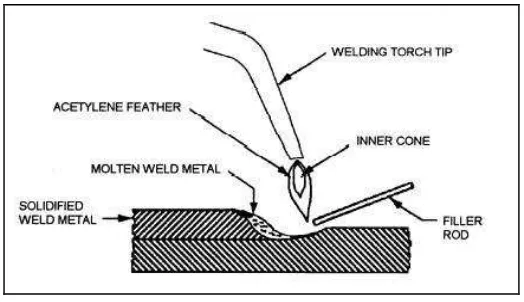UNIVERSITI TEKNIKAL MALAYSIA MELAKA
DESIGN AND FABRICATION OF WELDING JIGS AND
FIXTURES FOR FKP LAB
This report submitted in accordance with requirement of the Universiti Teknikal Malaysia Melaka (UTeM) for the Bachelor Degree of Manufacturing Engineering
(Manufacturing Process) (Hons.)
by
NAJIL BIN MAKONG
B051110298
921225-12-5047
DECLARATION
“I declare that this is my own work except for experts and summaries of each every one of them was me explain the source”.
Signature :………
APPROVAL
This report is submitted to the Faculty of Manufacturing Engineering of UTeM as a partial fulfillment of the requirements for the degree of Bachelor of Manufacturing Engineering (Manufacturing Process) (Hons.). The member of the supervisory is as follow:
………
ii
ABSTRACT
iii
DEDICATION
For my beloved family:
Makong bin Girah
Abda binti Muhamad
And
iv
ACKNOWLEDGEMNT
First of all, I would like to impress my appreciation and gratitude to Allah S.W.T for giving me the strength and ability to carry out the entire task and work given. In this great pleasure and gratitude also, I want to thanks to those who gave me the possibility to complete this report.
A special thank to my final year project supervisor Prof Madya Dr Md Nizam Bin Abd Rahman whose help, stimulating suggestions and encouragement, helped me to coordinate my project especially in writing this report. I would also like to acknowledge with much appreciation the crucial role of the staff of FKP’s Laboratory, who gave the permission to use all required machinery and the necessary material to complete the fabrication of fixture.
My special thanks goes to all of my friends that had supplied thought, advice, challenges, criticism, help and suggestion that have influenced my performance and increase my knowledge and understanding upon completing my Final Year Project. I would to appreciate the guidance given by other supervisor as well as the panels especially in our project presentation that has improved our presentation skills by their comment and tips.
viii
4.7 Fabricated Product 70
4.7.1 Welding Fixture Test Run Results 71
4.7.2 Discussion About Welding Fixture Product 72
4.7.3 Welding Fixture Can Improve Learning Process 74
4.7.4 Tool Can Reduce Heat Distortions and Time Consumption 75
4.7.5 Welding Fixture Used During Lab Session 76
4.7.6 Welding Fixture Can Improve Weld Quality 77
4.7.7 Summary of Results Questionnaire 77
4.8 Summary of Results and Discussions 78
CHAPTER 5: CONCLUSIONS AND RECOMMENDATIONS 79
5.1 Conclusions 79
5.2 Future Recommendations 79
REFERENCES 80
APPENDICES
A Survey Questionnaire – Welding Fixture For Lab Usage
ix
LIST OF TABLE
2.1 Physical and Thermal Properties of Selected Elements 12
3.1 Activities Schedule 35
4.1 Customer Needs 47
4.2 Bill of Materials of Concept A 50
4.3 Bill of Materials of Concept B 51
4.4 Bill of Materials of Concept C 52
4.5 Bill of Materials of Concept D 53
4.6 Rating References 55
4.7 Screening Sheet 56
4.8 Rating Guidance 58
4.9 Scoring Sheet 58
4.10 Planning for Fabrications 67
4.11 Estimated Budget 67
4.12 Bill of Materials of Welding Fixture 68
4.13 Gantt chart for Fabrication Planning 69
4.14 Time Usage During Welding Process 71
xi
4.9 The Purpose of Welding Fixture to be Made 46
4.10 House of Quality 49
4.11 Design for Concept A 50
4.12 Design for Concept B 51
4.13 Design for Concept C 52
4.14 Design for Concept D 53
4.15 Existing Product 54
4.16 Concept B Drawing by AutoCAD 61
4.17 Different Positions of Welding Fixture 61
4.18 Concept B with Four Different Parts 62
4.19 Clamping in Welding Fixture 64
4.20 Welding Fixture Product 70
4.21 Workpiece that been Weld Using Welding Fixture 71
4.22 Respondent that Agree this Tool can Improve Learning Process 74
4.23 End Users Agree a Tool Reduce Heat Distortion and Time Consumption 75
4.24 Respondents that Agree to Use Welding Fixture During Lab Session 76
xii
LIST ABBREVIATION, SYMBOLS AND NOMENCLATURES
BOM - Bill of Material
CAD - Computer Aided Design
CAFD - Computer Aided Fixture Design
CAFDV - Computer Aided Fixture Design Verification
CAM - Computer Aided Manufacturing
CAPP - Computer Aided Process Planning FKP - Fakulti Kejuruteraan Pembuatan
HOQ - House of Quality
GA - Genetic Algorithm
QFD - Quality Function Deployment
1 This chapter provides summary of the intended project. It consists of background of project, problem statement, objectives, scope and importance of the study.
1.1 Background of Project
According to Rajendar Singh (2006), welding is a process of joining two different parts by fusion or heat. Welding technique can be differentiated by the types of heat supplied during the process. The heat during welding process can be supplied by chemical reaction, gases, electric resistance or electric arc. Welding is suitable for most metal and is a permanent joint. In order to get the good welding joint, many parameters or conditions must be considered. One of the considerations that can facilitate welding process is the usage of welding fixtures.
Functions of welding fixtures are to hold, locate and support the workpiece during welding process. Similar to machining fixture, welding fixture consists of the locating and clamping elements. Locators are needed to position the part, while clamps are needed to hold the part in place and prevent any possible movements during welding process (Sivarao et al, 2014).
INTRODUCTION
3 1.3 Objectives
The objectives of this report are:
To design of welding fixture for usage of robotic welding. To fabricate a welding fixtures for lab usage.
1.4 Scope of Study
This project comprised of design considerations for welding fixture. For basic arc welding, the workpiece that considered is mild steel with length of 150mm, 50mm in width and 6mm of thickness (150mm × 50mm × 6mm). The fixture to be designed is for the butt joint, lap joint and T-joint. This fixture can be used for MIG, TIG and arc welding for both manual and robotic.
1.5 Importance of Study
4 This chapter provides the basic knowledge for the project finding by researchers and the methodology used by other researchers was summarized.
2.1 Welding Process
According to Hoffman (2004), the main assembly method used for joining process is welding as it provides the most efficient and economical way to join two or more individual components together. Other than welding, there are also other available joining processes, including brazing, soldering, riveting and stapling.
Young et al. (2012) stated that welding process involved melting of several pieces of base metal and the workpieces are joined together due to solidification of the pool of molten material. Filler material is always used to add materials to the weld joint. Welding is distinct from soldering and brazing where the weld joint for both latter processes is formed by melting of low-melting-point materials without melting of base metals or workpieces.
LITERATURE REVIEW
6
Figure 2.2: Application of Robot Welding. (Source :< http://robotiq.com/applications/>)
2.2 Jigs and Fixture
Jigs and fixtures in manufacturing industries can help to increase the productivity of the product. It also eliminates frequent checking, individual marking and positioning. Besides, jigs and fixtures reduce the demand of skill worker due to this particular tools can make the worker easier to machine or weld the parts. In addition, this jigs and fixtures is interchangeability which means that no need for selective assembly. Lastly, this can reduce the cost and reduce the scrap. A fit jigs or fixture can make sure reducing of scrap of material. (P.H Joshi, 2003).
7
Figure 2.3: Jigs and Fixtures. (Source :< http://www.tradeindia.com/fp300455/Jigs-Fixtures>)
According to Campbell (1994), fixture as a tool and was established to holds things. Fixture used to make or examine manufactured parts for industry. Fixtures might use to hold workpiece that going to into a stamping process, load them into a press, hold them during pressing, remove them afterward, hold them during assembly to other parts, and hold them during inspection. This clearly means that the fixtures have many usages and also can use to other purpose.
8
Figure 2.4: Vise as Fixture. (Source :< http://www.mitchellgolf.com/Repair-Tools>)
2.3 Welding Fixture
Jigar et al. (2013) stated that jigs or fixture in welding can influence in cost, quality and productivity. Besides, jigs or fixture can decrease the distortion that happen in the welding process. Welding fixture also can reduce manufacturing lead time for welding, holding parts, and positioning with reduction of production loss of welding. This could make student to finish their welding faster than usual. This also can improve the welding experience to student for their knowledge in the future or for working experience. Figure 2.5 below shows the example of welding fixture that used in one of workshop.




